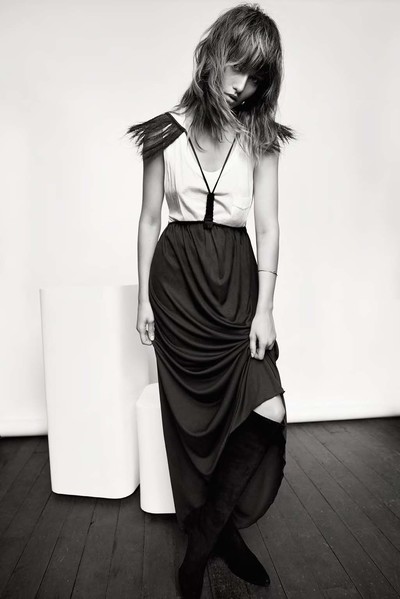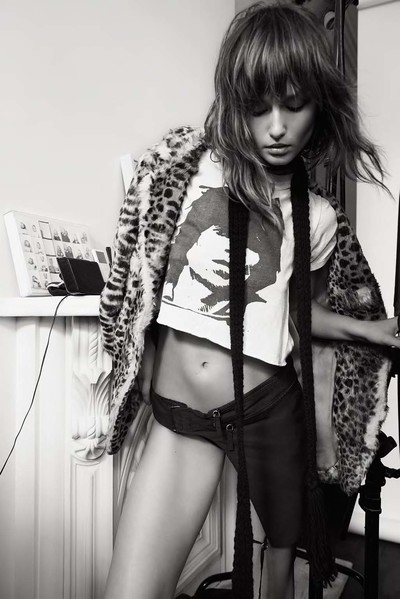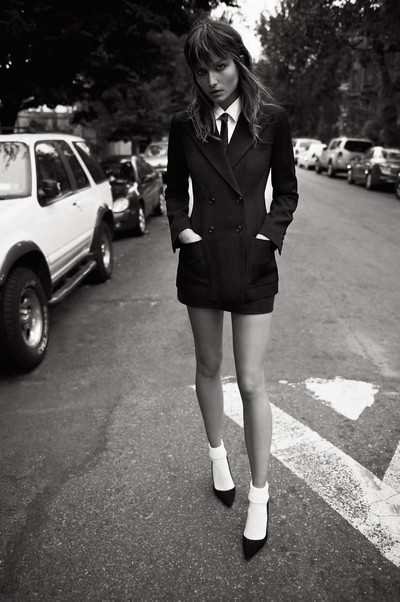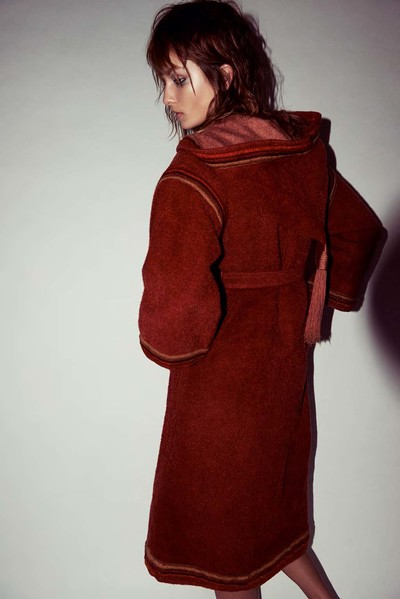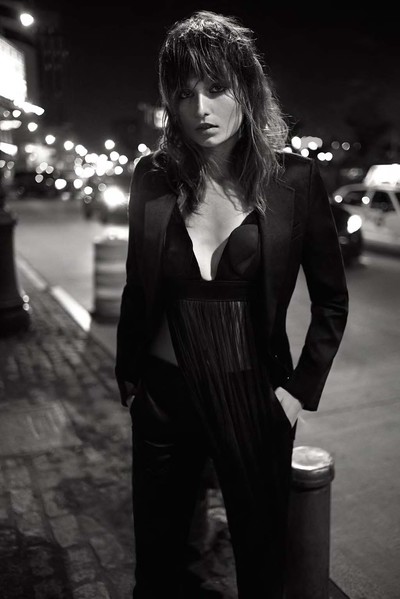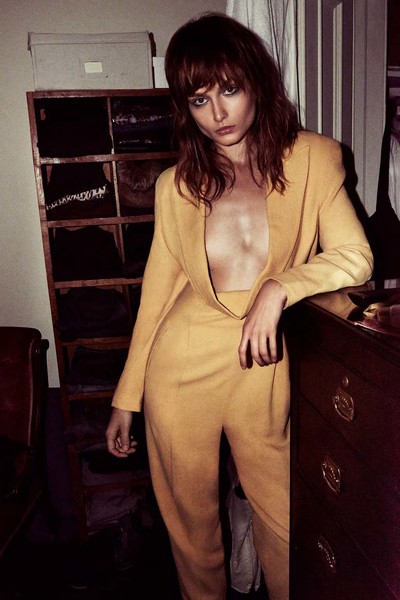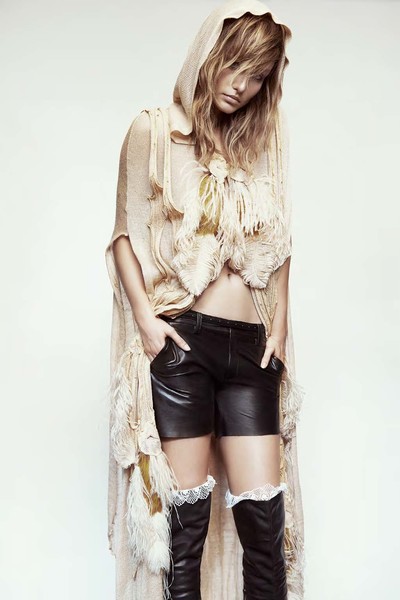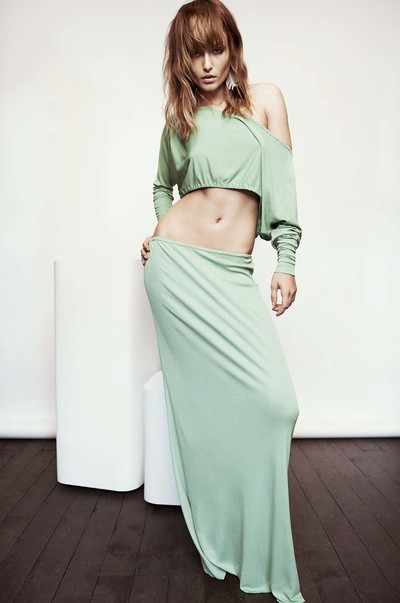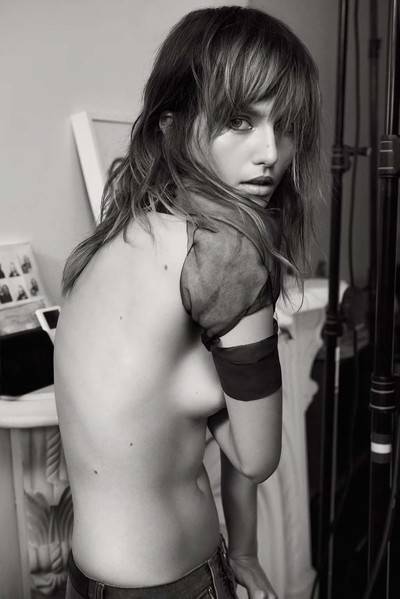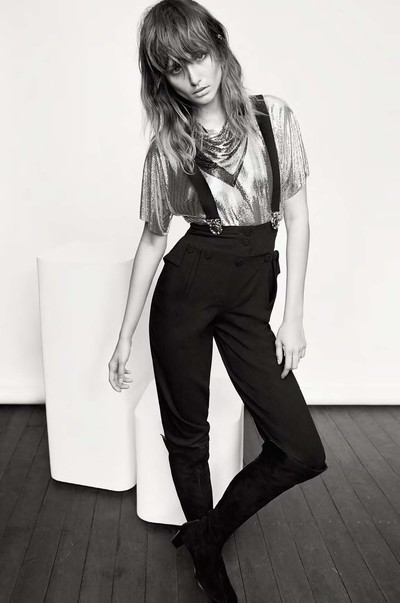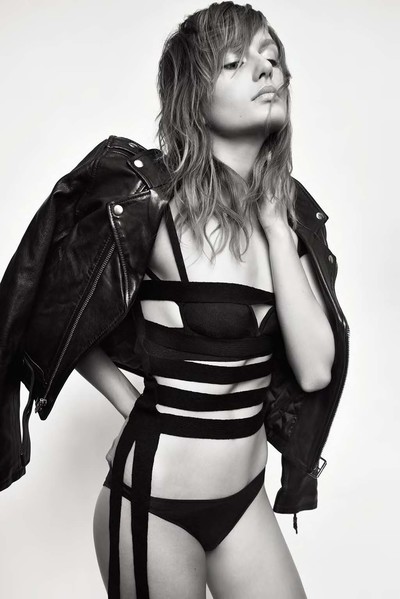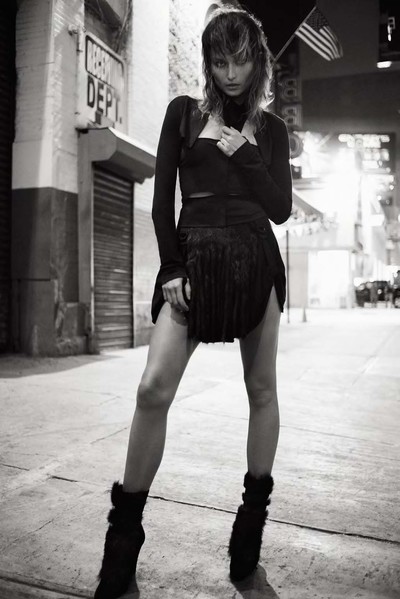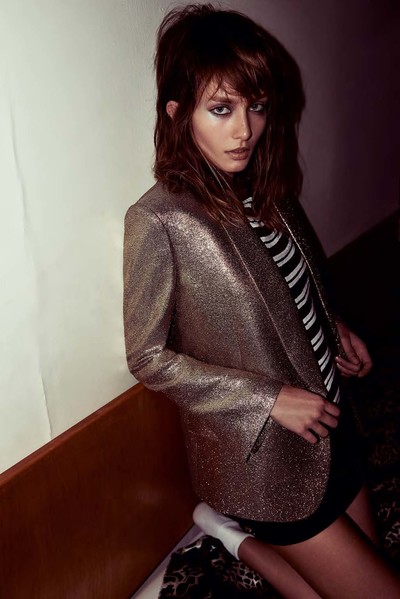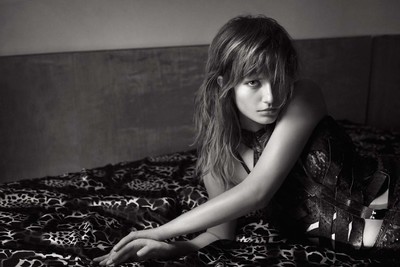The personal archive of style icon Melanie Ward.
By Jo-Ann Furniss
Styling by Melanie Ward
Portrait by Daniel Jackson
Photographs by Glen Luchford
The personal archive of style icon Melanie Ward.
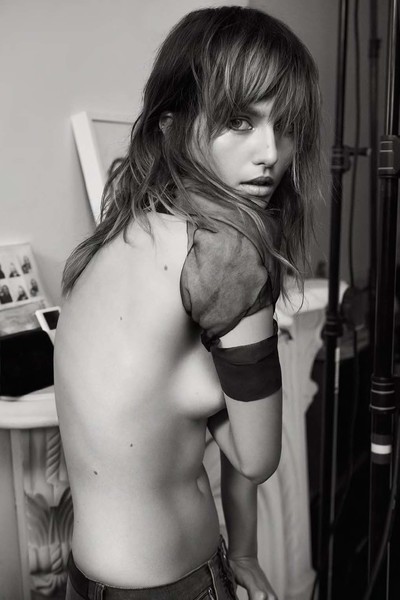
‘I don’t have an archive in the traditional sense, I have curated a rather large and ever burgeoning collection of vintage and contemporary clothing that I wear or have worn. I love clothing and accessories that have integrity. I developed an inherent sense of indulgence for fashion at a very young age facilitated by my mother, Honor. I have always responded more to certain dress codes from the street and music sub and counter cultures. That just felt more authentic with more spirit and soul. I believe that the street, fashion and music are inextricably linked. I personally tend to gravitate towards a certain code of dress and I instinctively continue to explore all of the possibilities of that style both personally and professionally.
Personal style has always been more defining and seductive for me than seasonal fleeting fashion dictates. Everything starts from an attitude, an allure, a confident, strong sense of self. It is less what you wear than how you wear it that constitutes style. Proportions and gesture define modernity for me and give a fresh attitude. While I am an exponent of the masculine, the androgynous, the utilitarian in all of its timeless simplicity and rigour, I also gravitate equally towards the undone, the sensual imperfection of the flou, the bohemian, the exotic.
When I began working in the fashion industry it was very instinctual. It was all about creativity, making clothes and customising vintage pieces. I have always possessed a certain irreverence towards clothes and I am never afraid to just rip into something with a pair of scissors. I personally love vintage cloth- ing for its individuality, but you can’t build the future by looking back, it is extremely limiting. I can be inspired by the romantic notion of nostalgia but it only works for me professionally if I make it my own. To partially quote Nietzsche “… no price is too high to pay for the privilege of owning yourself.”’
– Melanie Ward
‘I have always possessed a certain irreverence towards clothes and I am never afraid to just rip into something with a pair of scissors.’
‘You can’t build the future by looking back,’ says Melanie Ward. Although that maxim might be personally true for the stylist and reflects how she perceives her role in image-making, looking back at her ‘archive’ of clothing today – and the fact she does not like to call it an archive – and on her approach to making an image through an idea of character and personal style, it is a lesson that many in the fashion industry could take on board. It is an idea of living in the moment that visually, somehow, transcends time and space and gives Melanie Ward’s fashion images a timeless quality, a paradoxical quality of now no matter when they were shot, documented or originally witnessed. Something that is extremely rare in fashion, which is of course one of the defining measures of time and the moment.
To credit a stylist with an equal share, or sometimes even the lion’s share, of the image-making process is not really the done thing in fashion with its strict hierarchies and codes of creativity – and these are codes that Melanie Ward herself adheres to. But from being a teenager at the beginning of the 1990s, when I personally first became aware of Melanie Ward’s work through the pages of magazines like The Face, I can’t help but credit her in that way. The images she has worked on have a magic like nobody else’s for me, they generated an impression that has never quite left. Her fashion images, still so fresh and alive, have been a constant inspiration for my professional life – even though I am not a stylist. They are one of the benchmarks by which everything else is measured: how to achieve an attitude, a feeling, a resonance and an emotion through fashion, no matter what medium you may work in to convey it.
An idea of being anti-nostalgic might seem the opposite to achieving certain aims for Ward, but it is in fact the key. The constant, easy existence of a filtered past on the internet seems to encourage nostalgia. The worry of all that bombardment of information means that people find it impossible to create something that is new, or even looks new, not just in fashion but in many spheres that fashion has found integral to its existence. Instead there now exists a sort of meta-fashion, constantly consuming its own images and designs and never looking further than its boundaries. What Ward has done and continues to do is to believe in something beyond this meta-fashion. And this is in spite her being, as she puts it, ‘quite in love with the internet’.
Melanie Ward has the good fortune – or the extremely bad fortune – to have come to prominence as part of a generation whose work existed almost wholly in print and on the catwalk for the first ten years. These years were not and have not been extensively digitally documented. It gives this period of work a dream-like quality that exists on in the imagination for people who were paying attention to magazines at the time. At the same time it is a great shame that a younger, digital generation can only experience this work in fits and starts through books and the odd, scanned vintage magazine. It was an incredibly special period in fashion, of real significance: of the rise of Helmut Lang, David Sims, Corinne Day, Kate Moss… With all of whom Ward has shared defining working relation- ships. And yet this lack of digital documentation suits the ephemeral nature of styling. That tug between the ephemeral and the permanent in fashion always feels significant. It is why many of us work in the industry; it is almost the very definition of the moment.
This period of time also felt very special for its widespread, genuine lack of ‘commercial concerns’. To work in the fashion industry still felt like a job for people who did not want a job and perhaps here is where the conversation with Melanie Ward should begin. We begin with the quintessentially British years and move on to her years in America, where she lives now, although this conversation takes place in Milan, where she commutes to work. She describes her work best in her own words.
As she puts it: ‘Everything started for Dave [Sims], Corinne, Kate, myself, et al in that we totally lived in the moment. There were no grand plans apart from collaborating on great images and being creative. Interestingly enough it is how I still try to live my life. I am super conscious of it these days. So many people nowadays start in the business with an end goal in mind, ie, to be rich or famous. They forget the journey of self-discovery; to carve their own path through experiences and experimentation, getting to know who they are and being true to themselves. I really do try to remain centred on the here and now. If you don’t live in the now you almost give up your power to create. Practicing this is a very liberating experience. It is freeing because you are not stuck in the confines of the past or uncertainty of the future.’
Jo-Ann Furniss: How did your life in the fashion industry begin?
Melanie Ward: I just drifted into fashion in a weird way; it is almost strange to think that what I’ve done has had an influence on people. I was always passionate about clothes; I was always making things, sewing and customising vintage pieces. I went to university in London and I did a degree in languages and politics – and I was constantly making clothes when I was there. It was a twin life, like Sartre meets Portobello Market! I thought I was going to change the world. I thought I’d be a diplomat. And really it turned out you have to be a diplomat in fashion. We were all going out all of the time and somebody came up to me at a party, I was wearing a man’s jacket that I had customised, I had made it into this mini dress. This person asked me where I had bought it and I told them, then they just asked me to do some styl- ing for them. I did not really know what styling was so I took things from my closet and my mum’s closet – she always had so many incredible clothes – and I turned up with them. I was paid such a ton of money for this day of styling, it was a hair or beauty job – well it felt like a ton of money for me then – I thought, this is easy! When I graduated from university, I was doing all sorts of disparate things. I was writing in French, I was showroom modelling, I was trying to pay my way through Saint Martin’s – I attended a fashion course for a year.
When did the break though into editorial work really come for you? When did you meet your peer group that has in so many ways has defined what you do?
It all happened very quickly. I met Dave and Corinne in 1989, and that was when my first story was published in The Face. It was a ‘suburban space’ story with Nigel Shafran. Nigel and I used to work from where he lived in Golders Green. I used to drive round in my Triumph Herald, and we’d go to shopping centres and ask people to wear things. So I’d get some leopard coat from a big fashion house and ask a little old lady to wear it with her own clothes. We were always doing these projects. I loved that side of dressing people up and documenting things…
But still making sure people were their own selves…
Completely. It was always human, but an extravagant version of reality. Nigel has just brought out our Teenage Precinct Shoppers shoot as a little book. That shoot always obsessed Raf Simons. Nigel’s a genius and a nightmare! He never really wanted to do fashion – and never did really. He’s a giant talent.
I suppose it is really like a family, all of your peer group. You have all worked together for many years, from when you were first starting out and very young.
Yes, it’s impossible to choose between them and what they do and what they did. There’s also Dave, Glen, Corinne, Mario… I was discussing this with Mario Sorrenti not long ago. I think I was there when Mario met Kate; we are all like brothers and sisters. We all used to live in London together. We still all see each other all of the time.
I saw these relationships play out through the pages of magazines when I didn’t know any of you, through your images when you were all starting out. Some who only really know the later work and where all of your careers had progressed to by that point, could think that this is some sort of block- buster alliance.
I think we are all incredibly grounded and normal, it isn’t blockbuster in the slightest! I suppose people assume various things about us as a group, but information isn’t really knowledge. We have this whole history together, like a family. It was an idea of defining a world for me with all of them.
‘We were writing our own rules and functioning outside of the fashion industry. We were completely out of the system - nobody wanted to touch us. ’
How do you define yourself through clothing and what you do? What do you think are your signatures?
Mario Sorrenti once said to me, ‘Everyone thinks you’re a minimalist.’ We got in to a bit of a fight about it – he’s like my brother. I said, ‘I’m not a minimalist. I’ve never been a minimalist!’ I think I am more a modernist; I try and look forward. I don’t want to be limited too much by the past. I have been told my work is seductive, and that resonates with me. My main aim in life is always to go forward, so it is very hard for me to go back. That’s why doing a project like this is quite unusual, to look back at my old clothes. But it is always interesting to try and define a world. There is this weird, girly part of me that loves long gowns, but I think it is how you wear them that counts, you have to wear them with some irreverence. Then this other part of me loves menswear, because it is more about style rather than fashion, it’s more timeless. I suppose it is the attitude with which you wear clothes that matters most to me.
I always think of you appropriating certain distinctive clothes and making them your own in the images you have produced, like John Lewis school uniforms…
I used to hang out in John Lewis’ schoolboy department. I used to buy little grey suits because that’s what fit- ted me and I liked the boyish proportions. I then used to shoot them on Rose or Kate or on Emma Balfour if I was with Dave. And, of course, there were all the amazing boys we shot too. I used to have to wait to make sure no 13-year-old schoolboys were around; I’d quickly have to duck into the changing rooms and try things on. Then there were the sex shops. After grunge, Dave and I particularly moved into this other territory, he was really experimental with his light, and I was going a lot to sex shops to find clothes. In sex shops there would always be these great PVC pants, there would be these amazing rubber straps where you could make a belt or a top by wrapping them round. It wasn’t so much a bondage thing; it was just some different cool styling thing. Or there would be the idea of putting some ridiculous thing on a guy, like a pair of Speedos with a lace top and then Dave would photograph that. I think I almost went straight from John Lewis to the sex shops! I remember trailing round sex shops in Pigalle in Paris, and I tell you, I saw some sights. I was always on a crazy hunt in some weird or banal place just for something to photograph.
But your styling has this uncanny knack of never looking like it is trying too hard…
For me it always is this effortless thing, the concept of an effortless way of dressing. Your clothes don’t wear you; they should never scream fashion too loud. That’s what I find really modern. When we started the grunge movement – as it’s called – I wanted for the kids to look a certain way… I say kids although we were all similar ages, it was dressing up people, but these are things we were also dressing in ourselves. It was easy; it was like putting on your clothes and going out. And that is still really my approach now. I suppose this has become the norm now.
I think what you did was to define an idea of a character in a fashion shoot, who you photographed mattered as much as the clothes. There was a sense of equality between everyone, male and female, subject and object; you couldn’t really pull any of that apart.
I suppose what we were doing was weirdly voyeuristic, particularly for Dave and me. We were staging it clearly, but there was a sense of voyeurism. And I suppose that was true of the work I did with Corinne too, although there we had the beautiful Kate. Kate’s beauty was more tangible I suppose. She is the most beautiful creature ever and the most amazing model and actress ever. Maybe she wasn’t the height of an Amazon and had slightly imperfect teeth, she also had this incredible personality as well as that beauty.
She also had a personal style of her own. In many ways it was the idea that any of you could have been the stylist, any of you could have been the photographer and any of you could have been the model, particularly with yourself, Corinne and Kate.
We really were living this life. I was talking about this with Glen Luchford recently. We were all at this party together, and he was documenting it. Glen was really mixing drinks and it all got very bad, to the point where all three of us needed to vomit at the same time. I had been going a lot to see John Galliano with Kate and hanging out with him, and I remember all three of us had these maxi skirts from John. We all literally jumped up at the same time, tripped up over each other’s maxi skirts and ran to the bathroom. One of us threw up in the toilet, one in the sink and one through the open window. We were like these three little peas in a pod. Kate is like my little sister, she always was, and she always will be.
I think that is something you feel in those early photographs, a sense of true camaraderie and equality.
It was a real lifestyle; there was a sense of something happening that was authentic in those photographs.
Many people seem to have stopped trying to build a world in photographs and have become too busy maintaining a fictitious lifestyle. Of course there are exceptions…
I say the word authentic over and over again. When somebody is not trying to play at being who he or she is, it is authentic. Being true to yourself is what matters. Being true to yourself, being comfortable in your own skin is important. I was discussing the idea of ego with somebody and they’d decided having some ego is important because you know who you are, can protect yourself with it and draw boundaries. But sometimes – and I know I always try and see the good side of things and that is annoying for people, like I’ll always see a murder from a murderers point of view as well! – I just feel that if you are true to yourself and control your ego things are different. There are a lot of egos in this business, and if that ego is coming from a place of insecurity, it is almost like a false pride.
‘Nowadays as a stylist or editor, it is more limiting. People aren’t looking for a point of view from the stylist: they are looking for you to shoot look 17. ’
How did you feel when you really entered the fashion industry, by going to Harper’s Bazaar in America in the mid-1990s?
I had absolutely no interest in America at first. It was not a place that appealed to me at all. I have never been a great planner, I just always go with my gut, always have, always will. Decisions I make come from an emotional place. I feel that things always just come into my life, and that is true of all the people I started out with. We were not following this dream to become successful, or wealthy or move to America, to buy an apartment or just buy things. We were just having the best time expressing ourselves and doing what we felt. We were essentially writing our own rules and functioning outside of the fashion industry. We were not accepted by the industry, apart from Ronnie Cooke Newhouse, or Ronnie Cooke, as she was known then, before she married Jonathan. Ronnie discovered us very early on, and she told Calvin Klein about us. But it was a time when we were kids experimenting. We were completely out of the system, working with bands – because nobody in the fashion industry wanted to touch us – and we weren’t doing it to revolt, we were just having fun. We were playing and expressing ourselves and having the best fun ever. Now, maybe, people think that you can only change things from within the system. The advent of bloggers was different, and now that has become big business too.
But I also think, for the most part, they too wanted a way in…
That’s the difference. We didn’t want a way into the system. All we wanted to do was go to the beach and take pictures! It was such a different time. I suppose people now enter into all of this wanting it to be their career.
And yet you went to America, embraced the fashion system, and you still live there today…
Meeting Liz Tilberis, who was editing Harper’s Bazaar at the time felt right, again it was a gut decision. She had been the bad girl at British Vogue and she really wanted me to be the bad girl at Bazaar. I suppose I am so quintessentially British, European I guess. I definitely am a European living in America. I hate to generalise, it’s sort of crass, but I feel there are certain areas where people embrace newness in America. There is openness to newness; it is embraced with enthusiasm. As Brits we might go into things a little deeper at times, but there is also more cynicism. We’re more guarded.
Was being at a big American publication a shock to your British sensibilities at first?
When I first started at Harper’s Bazaar, some designers would literally put on a second show for us with models in the looks. That is the power of one of those big, American publications. I remember gripping the table, about to fall over in my heels. I’d be so tired. It’s like an assault course going to the shows. I remember I was in Italy once, about on my way to a Nicolas Ghesquière show for Callaghan I think. It was at a time when Italy was full of squat toilets, and I desperately needed to pee. I remember I was wearing a pair of red Yves Saint Laurent heels and red socks. I went to one of these toilets, and I remember I managed to pee on my socks – I was sat in the front row with pee all over my socks! It was so absurd.
You have a long history working with designers. But the quintessential working relationship you had for many of us is that one you shared with Helmut Lang.
Helmut used to call me the nicest pit bull he ever met. If I feel something I can’t let it go! I have not seen him for years now. We have very different lives. But I definitely think it was a prolific time. It was a definite moment.
Which do you prefer, working with designers on collections and shows or making images?
I like all of it. I wouldn’t just want to do one or the other. I like working on images and with designers, making clothes, the whole lot. I thrive more by doing more than one thing. Brand building interests me; it is pivotal at the moment. Again, it is brands essentially knowing what they are and knowing how to define that. I want to work on more of that.
Do you ever feel nostalgic for the way things were in the early days of your career?
In those days, what was going on editorially was inspiring designers in their work. I might have been making a weird pair of sleeping-bag shorts for Emma Balfour to wear or some sort of denim cloak to be photographed by Dave. But nowadays, as a stylist or an editor, it is far more limiting. Sometimes you are just deciding if it is a side parting or a centre parting. With the nature of advertising, people are not necessarily looking for a point of view from the stylist; they are looking for you to shoot look number 17. Saying that, I don’t know whether I am nostalgic for the past, I don’t necessarily want it to repeat. I’ve been there and done it, and I want to do something new now. I am still insatiably curious and I love to challenge myself.
Model: Andreea Diaconu @ IMG.
Hair: Shay Ashual c/o Tim Howard Management.
Make-up: Wendy Rowe c/o Tim Howard Management. Manicure: Yuko Tsuchihashi for Chanel Beauté.
Photo Assistants: Lance Cheshire & Doug Bruce.
Digital Technician: Aron Norman.
Lighting Technician: Jack Webb.
Equipment Technician: Braulio Moz.
Stylist Assistant: Courtney Kryston.
Make-up Assistant: Aliana Lopez.
Hair Assistants: Taichi & Saito Tsuyoshi.
Tailor: Hwa Park.
Props: Louise Hinnen c/o The Factory.
Manicure: Yuko Tsuchihashi for Chanel Beauté.
